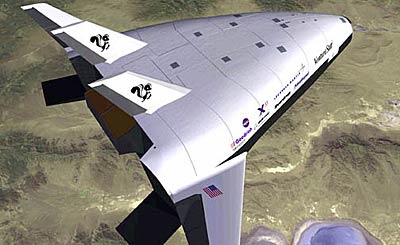America’s RLV industry in 2004by Taylor Dinerman
|
| Whatever its technological virtues, the shuttle will probably be the last attempt to build a multi-purpose spaceplane. |
In contrast, the Department of Defense has recently led a relatively successful launch vehicle development program, the EELV. These are not RLVs, but the mere fact that they were able, within six or seven years, to set out their requirements and get the contractors to actually build a pair of rocket families that work is, by NASA standards, a miracle. The development process was easier because neither the Delta 4 nor the Atlas 5 were built from scratch. Yet, both rockets were, for the most part, new vehicles.
The requirements for the next generation of military space launch systems have not yet been decided. The leadership at the Pentagon is still trying to figure out what will be needed ten or twenty years from now. Long range planning of this sort is never easy and with space systems it seems to be particularly difficult. Ten years from now, the world may be full of nations with well-established counterspace systems, including kinetic, electronic or laser/directed energy attack weapons. Certainly such weapons will be widely available by 2020. In fact, there will probably be an open market for such weapons and their components.
Strategic planners will also have to consider what kind of space systems the US military will want to launch in the ten- to twenty-year time frame. Will the US still be using heavy, expensive, and vulnerable satellites, such as DSPs, Milstars, Keyholes and Lacrosses? Will the next generation of military satellites really be light, low-cost, networked (or swarming) systems built on assembly lines and easily replaceable? Or will they be something in between, such as today’s GPS and perhaps tomorrow’s FIA spacecraft? A prudent planner would assume that in 2015, Space Command will have control over all these types and will have to base his or her recommendations on that very expensive assumption.
If so, it follows that the military will want to keep the EELVs in service and support a replacement for the Delta II—perhaps the SpaceX Falcon 5 or its derivatives. They will also want to build a new generation of low-cost rapid response rockets to maintain and replace the next generation of small satellites. Today, the US does have a wide variety of launch systems. This may give our planners some interesting choices, but it does not make for low cost efficiency or a healthy industrial base.
One way or another, the US is going to get into the space weaponization business. It may be due to a conscious decision on the part of US political leaders or it may forced on them due to foreign developments. All it would take would be one more incident, such as the 1986 refusal by France to allow US overflight rights, to convince America’s leaders that space-based, or space-transiting, weaponry that does not have to pass though anyone’s sovereign airspace is an urgent requirement. The Congress seems to understand this and has given the DoD a modest increase in funding for the Operationally Responsive Spacelift program.
Combined with a variety of technology maturation programs, it is possible that by the end of the decade, the Defense Department could be in a position to begin a full-scale military RLV program. If they can be sure that the technology readiness level (TRL) process is working the way it should and if there have been enough successful demonstrations, such as the X-43A, then RLV development can begin with a high level of confidence. The last thing the DoD needs is to emulate NASA’s habit of launching programs like the X-30 and X-33, with only a vague idea of how well both they and their contractors understand the problems involved.
| It is possible that by the end of the decade the Defense Department could be in a position to begin a full-scale military RLV program. |
Already America’s space warriors have shown themselves willing to reach outside their usual stable of contractors. They plan to launch the experimental communications satellite TacSat 1 on the SpaceX Falcon 1 later this year from Vandenberg AFB in California. Falcon is a semi-reusable rocket based simple and well-understood engineering concepts. Along with its bigger brother, Falcon 5, it promises to be the best and most reliable, low-cost launch vehicle on the world market. If SpaceX can make money selling launches for $5.9 million on Falcon 1 and $12 million for Falcon 5 (plus range costs) the long-term economics of spaceflight will be revolutionized.
For the US RLV industry, the best news of all has little, if anything, to do with the government and everything to do with the spirit of American capitalism. When the Ansari X Prize competition began in 1996, almost no one imagined that it would not only spark a renaissance in small, barnstorming-style rocketry, but that it would create an industry that would provide the US aerospace industry as a whole with some desperately needed creative energy.
Burt Rutan’s Scaled Composites and their engine maker, SpaceDev, have shocked and thrilled the world with the test flights of SpaceShipOne. Along with the other X Prize teams, they are creating an industry from almost nothing. As with the digital revolution of the 1980s and 1990s, the spacelift revolution of the 2010s and 2020s will change the way people live and will open a new and fascinating chapter in the history of human technology.
